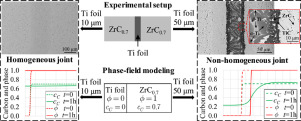当前位置:
X-MOL 学术
›
Acta Mater.
›
论文详情
Our official English website, www.x-mol.net, welcomes your feedback! (Note: you will need to create a separate account there.)
Interfacial energy as the driving force for diffusion bonding of ceramics
Acta Materialia ( IF 9.4 ) Pub Date : 2020-03-01 , DOI: 10.1016/j.actamat.2020.01.015 S. Kovacevic , R. Pan , D.P. Sekulic , S.Dj. Mesarovic
Acta Materialia ( IF 9.4 ) Pub Date : 2020-03-01 , DOI: 10.1016/j.actamat.2020.01.015 S. Kovacevic , R. Pan , D.P. Sekulic , S.Dj. Mesarovic

|
Abstract Diffusion bonding of ceramics with a metallic interlayer can give a variety of very complex joint microstructures, which are highly influenced by ceramic compositions, the material and thickness of the interlayer, bonding temperature as well as time at the peak bonding temperature. Experiments with a diffusion bonding of ZrC using a Ti interlayer clearly show that under a certain bonding condition, a seamless joint with the total dissolution of the interlayer can be obtained. They also indicate the existence of the critical interlayer thickness, below which the seamless homogeneous joint domain is obtained, and above which the joint does not homogenize. The key process leading to these outcomes is the diffusion of carbon from ZrC into Ti, which, when the critical carbon concentration is reached, initiates the phase transformation of bcc Ti to TiC, while the binary Zr/Ti diffusion is then driven by entropy and results in a seamless Zr(Ti)C joint. We first show that the dependence of ZrC/Ti interfacial energy on the carbon concentration jump across the interface is the main thermodynamic driving force of the diffusion of carbon from ZrC to the Ti interlayer. Then, we show that the characteristic length (critical thickness of the interlayer) arises as the ratio of this driving force (energy/area) and the bulk energy densities, which oppose the carbon diffusion. Finally, we develop a diffuse interface (phase-field) model to simulate the process. The novelty in the phase-field model is the introduction of a dependence of the interfacial energy on the carbon concentrations on the two sides of the interface. The critical thickness of the interlayer is estimated employing both models and good agreement with experimental findings is obtained.
中文翻译:

界面能作为陶瓷扩散结合的驱动力
摘要 陶瓷与金属夹层的扩散结合可产生多种非常复杂的接头微观结构,这些微观结构受陶瓷成分、夹层材料和厚度、结合温度以及达到峰值结合温度的时间的影响很大。使用 Ti 夹层进行 ZrC 扩散结合的实验清楚地表明,在一定的结合条件下,可以获得夹层完全溶解的无缝接头。它们还表明临界层间厚度的存在,低于该厚度将获得无缝均质接头域,高于该厚度时接头不会均质化。导致这些结果的关键过程是碳从 ZrC 扩散到 Ti,当达到临界碳浓度时,启动 bcc Ti 到 TiC 的相变,而二元 Zr/Ti 扩散然后由熵驱动并导致无缝 Zr(Ti)C 接头。我们首先表明 ZrC/Ti 界面能对跨界面的碳浓度跳跃的依赖性是碳从 ZrC 扩散到 Ti 夹层的主要热力学驱动力。然后,我们表明特征长度(夹层的临界厚度)是作为该驱动力(能量/面积)与体积能量密度的比值而产生的,这与碳扩散相反。最后,我们开发了一个扩散界面(相场)模型来模拟该过程。相场模型的新颖之处在于引入了界面能对界面两侧碳浓度的依赖性。
更新日期:2020-03-01
中文翻译:

界面能作为陶瓷扩散结合的驱动力
摘要 陶瓷与金属夹层的扩散结合可产生多种非常复杂的接头微观结构,这些微观结构受陶瓷成分、夹层材料和厚度、结合温度以及达到峰值结合温度的时间的影响很大。使用 Ti 夹层进行 ZrC 扩散结合的实验清楚地表明,在一定的结合条件下,可以获得夹层完全溶解的无缝接头。它们还表明临界层间厚度的存在,低于该厚度将获得无缝均质接头域,高于该厚度时接头不会均质化。导致这些结果的关键过程是碳从 ZrC 扩散到 Ti,当达到临界碳浓度时,启动 bcc Ti 到 TiC 的相变,而二元 Zr/Ti 扩散然后由熵驱动并导致无缝 Zr(Ti)C 接头。我们首先表明 ZrC/Ti 界面能对跨界面的碳浓度跳跃的依赖性是碳从 ZrC 扩散到 Ti 夹层的主要热力学驱动力。然后,我们表明特征长度(夹层的临界厚度)是作为该驱动力(能量/面积)与体积能量密度的比值而产生的,这与碳扩散相反。最后,我们开发了一个扩散界面(相场)模型来模拟该过程。相场模型的新颖之处在于引入了界面能对界面两侧碳浓度的依赖性。



























 京公网安备 11010802027423号
京公网安备 11010802027423号